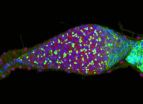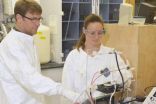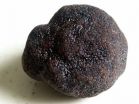(Press-News.org) BOULDER, Colo -- Physicists at the National Institute of Standards and Technology (NIST) have demonstrated a pas de deux of atomic ions that combines the fine choreography of dance with precise individual control.
NIST's ion duet, described in the August 7 issue of Nature, is a component for a flexible quantum simulator that could be scaled up in size and configured to model quantum systems of a complexity that overwhelms traditional computer simulations. Beyond simulation, the duet might also be used to perform logic operations in future quantum computers, or as a quantum-enhanced precision measurement tool.
In the experiments, researchers coaxed two beryllium ions located in separate zones of an electric-field trap (a storage device) into an "entangled" state. An important resource for quantum technologies, entanglement involves an intimate connection between the particles such that a measurement of one ordains the state of the other. This is the first time ions in separate zones have been entangled by manipulating their electric interactions, an important feature that could be used in quantum simulation and computing.
The work demonstrates a high level of quantum control with microfabricated trap technology well suited to the scaling-up needed to make powerful quantum information processors. Having separate trapping zones enabled the research team to tune the ions' interactions from weak to strong—a feature expected to be useful for simulating the behavior of complex quantum materials.
"Even though the ions are confined apart from one another, we can now entangle them," NIST physicist Andrew Wilson says. "We plan to use this for quantum simulation and computing, but when I explain to my family what we're doing, the remote entanglement sounds kind of romantic."
"We focus on the idea that everything needs to be scalable," Wilson notes. "To do useful simulations we'll need versatile traps with more than two ions, and making traps using the same technology used to make computer chips gives us this capability. NIST pioneered this approach and we're fortunate to have great facilities for doing this sort of work."
Inducing the ions to perform a number of intricate quantum dances, the researchers first coaxed the ions to exchange a single quantum of vibrational energy (the smallest amount that nature allows). They then used lasers and microwaves to entangle the ions' "spins." Analogous to tiny bar magnets, the spins of the entangled ions pointed in the same direction, but were also in a "superposition" of pointing in the opposite direction at the same time. Superposition is another strange but useful feature of the quantum world.
The researchers say that extending the new module to make a two-dimensional network of a few tens of ions would be enough to perform useful simulations of phenomena that are extremely difficult to model even on the most powerful traditional computers. An example is the high-temperature superconductitivity—electron flow without resistance—observed in certain ceramics. Despite more than 20 years of study, the underlying mechanism remains a mystery. A quantum simulator might provide deeper insights.
The ion duet also could be used to perform logic operations in quantum computers, which would have a wider range of applications than quantum simulators. And NIST researchers also envision the ion duet as a sensor, in which one well-controlled ion is used to investigate a second ion with interesting features. For instance, a beryllium ion might be used to probe a charged anti-matter particle in another trap zone, Wilson says.
INFORMATION:
This research was funded by the Office of the Director of National Intelligence, the Intelligence Advanced Research Projects Activity and the Office of Naval Research.
A.C. Wilson, Y. Colombe, K.R. Brown, E. Knill, D. Leibfried and D.J. Wineland. Entangling spin-spin interactions of ions in individually controlled potential wells. Nature. August 7. DOI 10.1038/nature13565.
NIST ion duet offers tunable module for quantum simulator
2014-08-06
ELSE PRESS RELEASES FROM THIS DATE:
Stowers researchers reveal molecular competition drives adult stem cells to specialize
2014-08-06
KANSAS CITY, MO — Adult organisms ranging from fruit flies to humans harbor adult stem cells, some of which renew themselves through cell division while others differentiate into the specialized cells needed to replace worn-out or damaged organs and tissues.
Understanding the molecular mechanisms that control the balance between self-renewal and differentiation in adult stem cells is an important foundation for developing therapies to regenerate diseased, injured or aged tissue.
In the current issue of the journal Nature, scientists at the
Stowers Institute for ...
Enhanced international cooperation needed in Antarctica
2014-08-06
Countries need to work together to ensure Antarctic research continues and key questions on the region are answered, researchers say.
In an article published in Nature this week, 75 scientists along with policy makers in 22 countries have outlined what they see as the major priorities for Antarctic research over the next 20 years and beyond.
In it they outline six priorities for Antarctic science – the most important scientific questions to be addressed in the region, as well as what they think is needed to achieve them.
One of the report's lead authors, Monash University ...
Mercury in the global ocean
2014-08-06
Although the days of odd behavior among hat makers are a thing of the past, the dangers mercury poses to humans and the environment persist today.
Mercury is a naturally occurring element as well as a by-product of such distinctly human enterprises as burning coal and making cement. Estimates of "bioavailable" mercury—forms of the element that can be taken up by animals and humans—play an important role in everything from drafting an international treaty designed to protect humans and the environment from mercury emissions, to establishing public policies behind warnings ...
Farm manager plays leading role in postharvest loss
2014-08-06
URBANA, Ill. – With all the effort it takes to grow a food crop from seed to sale, it may be surprising that some farms in Brazil lose 10 to 12 percent of their yield at various points along the postharvest route. According to a University of Illinois agricultural economist, when it comes to meeting the needs of the world's growing population that's a lot of food falling through the cracks. Interestingly, farm managers who are aware of the factors that contribute to postharvest grain loss actually lose less grain. This was one of the findings in a study that examined how ...
NASA satellite paints a triple hurricane Pacific panorama
2014-08-06
In three passes over the Central and Eastern Pacific Ocean, NASA's Terra satellite took pictures of the three current tropical cyclones, painting a Pacific Tropical Panorama. Terra observed Hurricane Genevieve, Hurricane Iselle and Hurricane Julio in order from west to east. Iselle has now triggered a tropical storm watch in Hawaii.
The Moderate Resolution Imaging Spectroradiometer or MODIS instrument is a key instrument aboard NASA's Terra and Aqua satellites. Between the two satellites, MODIS instruments view the entire surface of the Earth every one to two days. When ...
Most kids with blunt torso trauma can skip the pelvic X-ray
2014-08-06
WASHINGTON – Pelvic x-rays ordered as a matter of course for children who have suffered blunt force trauma do not accurately identify all cases of pelvic fractures or dislocations and are usually unnecessary for patients for whom abdominal/pelvic CT scanning is otherwise planned. A study published online in Annals of Emergency Medicine last week casts doubt on a practice that has been recommended by the Advanced Trauma Life Support Program (ATLS), considered the gold standard for trauma patients "(Sensitivity of Plain Pelvis Radiography in Children with Blunt Torso Trauma). ...
Scientists discover how 'jumping genes' help black truffles adapt to their environment
2014-08-06
Black truffles, also known as Périgord truffles, grow in symbiosis with the roots of oak and hazelnut trees. In the world of haute cuisine, they are expensive and highly prized.
In the world of epigenetics, however, the fungi (Tuber melanosporum) are of major interest for another reason: their unique pattern of DNA methylation, a biochemical process that chemically modifies nucleic acids without changing their sequence. Epigenetics is the study of changes in gene expression caused by mechanisms other than changes in the DNA sequence.
A newly published study in the journal ...
Wiki ranking
2014-08-06
Wikipedia the free, online collaborative encyclopedia is an important source of information. However, while the team of volunteer editors endeavors to maintain high standards, there are occasionally problems with the veracity of content, deliberate vandalism and incomplete entries. Writing in the International Journal of Information Quality, computer scientists in China have devised a software algorithm that can automatically check a particular entry and rank it according to quality.
Jingyu Han and Kejia Chen of Nanjing University of Posts and Telecommunications, explain ...
A new way to model cancer
2014-08-06
CAMBRIDGE, MA -- Sequencing the genomes of tumor cells has revealed thousands of mutations associated with cancer. One way to discover the role of these mutations is to breed a strain of mice that carry the genetic flaw — but breeding such mice is an expensive, time-consuming process.
Now, MIT researchers have found an alternative: They have shown that a gene-editing system called CRISPR can introduce cancer-causing mutations into the livers of adult mice, enabling scientists to screen these mutations much more quickly.
In a study appearing in the August 6th issue of ...
Discovery yields master regulator of toxin production in staph infections
2014-08-06
St. Jude Children's Research Hospital scientists have discovered an enzyme that regulates production of the toxins that contribute to potentially life-threatening Staphylococcus aureus infections. The study recently appeared in the scientific journal the Proceedings of the National Academy of Sciences (PNAS).
Researchers also showed that the same enzyme allows Staphylococcus aureus to use fatty acids acquired from the infected individual to make the membrane that bacteria need to grow and flourish. The results provide a promising focus for efforts to develop a much-needed ...





